Introduction
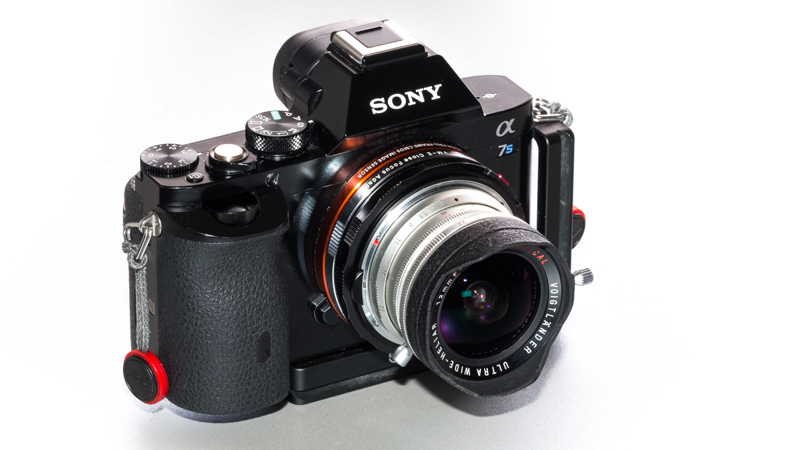
The Voigtländer 12mm 5.6 Ultra Wide Heliar is actually one of the lenses I bought a camera from the A7 series for in the first place. It is worth to mention though, I am reviewing the old M39 version here. The newer Leica M version is optically the same, although there are other differences – apart from the lens mount – which I will talk about at the end of this review.
Sample Images
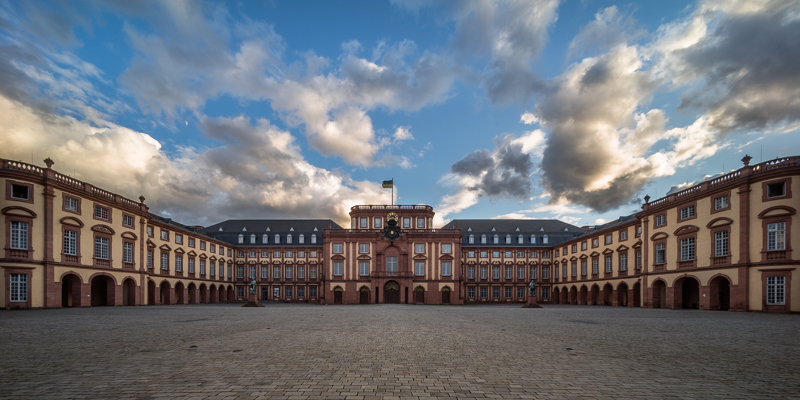
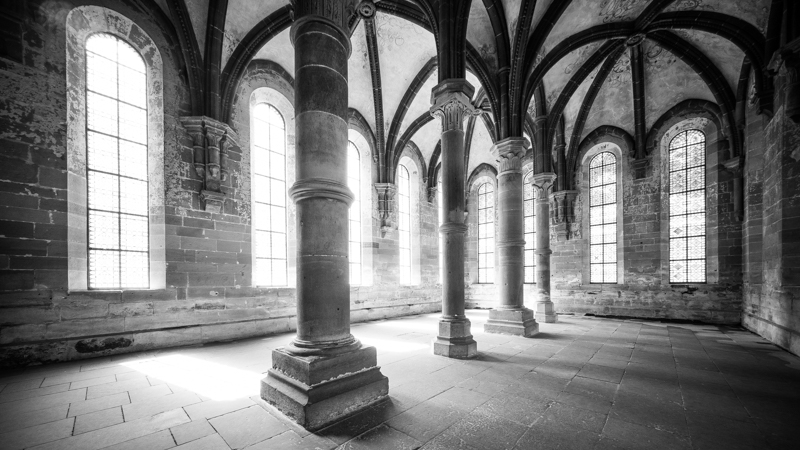
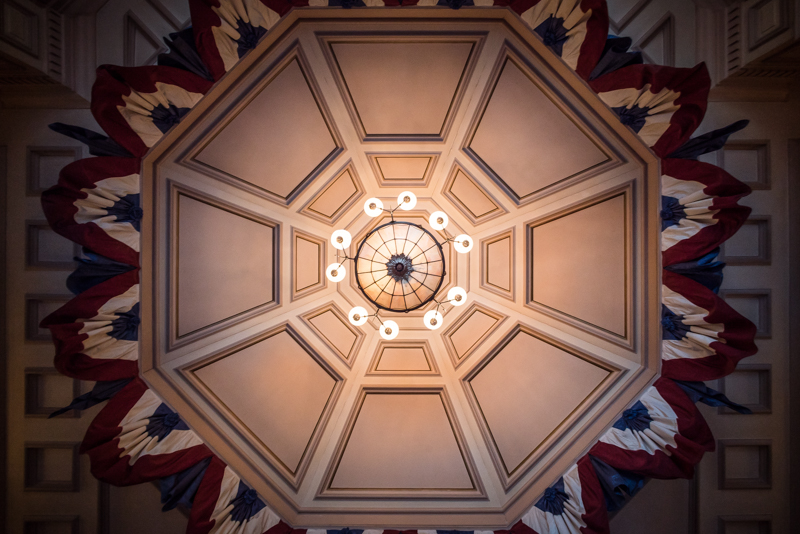
Specifications
M39 Version:
-
- Diameter: 50.5 mm
- Field of view: 121° (diagonally)
- Length: 38.2 mm
- Weight: 175g
- Filter Diameter: see chapter “Use with filters”
- Number of Aperture Blades: 9 (straight)
- Elements/Groups: 10/8
- Close Focusing Distance: 30 cm
- Mount: M39
For the newer Leica M version take a look at the official data sheet.
The Voigtländer 12mm 5.6 Ultra Wide Heliar M39 usually sells for around $550 at ebay.com (affiliate link).
In Germany you can buy it for 400-600€ at ebay.de (affiliate link).
Handling
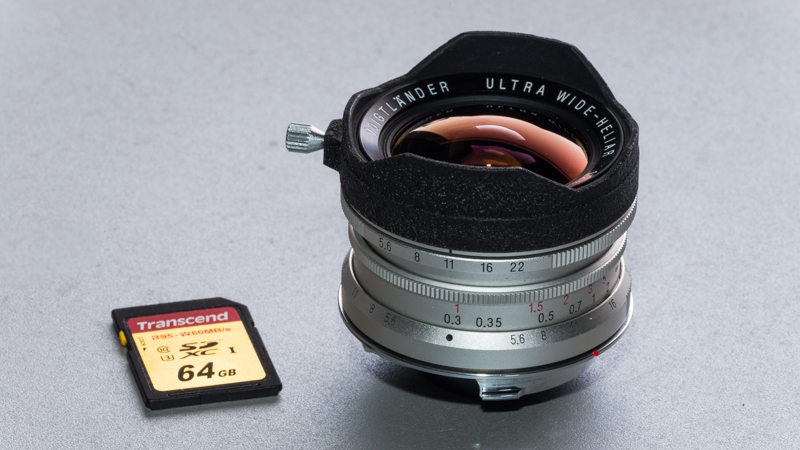
This is a tiny lens, just take a look at the picture. I even included an SD-card, so you may grasp how small it really is. Apart from that, handling is superb! You are probably used to half a stop click stops on the aperture ring but this lens has click stops on the focusing ring as well (@ 0.3m, 0.5m, 1.0m, infinity)! I haven’t seen this on any other lens yet. But to be honest: my lens is always set at infinity and everything is in focus. I don’t like this lens for close up photography because you have to put your subject right in the center of the frame, otherwise it will be distorted in quite an ugly way.
Vignetting and colorcast
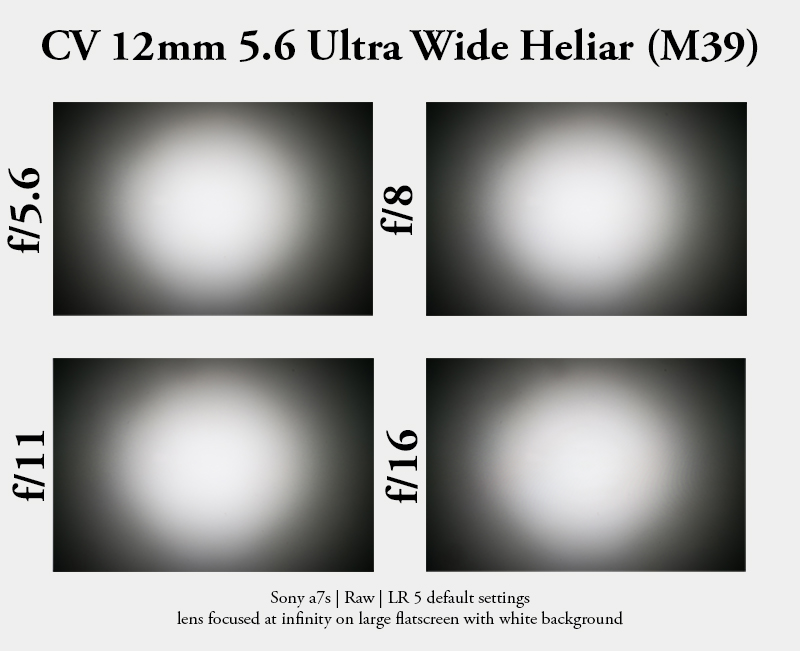
I recommend reading the “Leica M wideangle lenses and the A7 series” section in my Voigtländer Ultron 28mm 2.0 review on this very same blog first before going further. I have used this lens with the original A7 and the A7s. With the original A7 you get magenta cast in the corners while with the A7s you get a slight green cast. The vignetting is quite severe throughout the whole aperture range (actually, stopping down won’t reduce the vignetting by a meaningful amount at all), which is no surprise because of the symmetrical design of the lens in conjunction with the extreme wide 12mm focal length. Still, it is possible that the sensor design has a negative influence here as well.
Both things can be corrected (e.g. with Adobe Lightroom) as I will show in the before/after example below. Remember though: correcting the light fall off completely may lead to visible noise in the corners.
Sony A7s | Voigtländer Ultra Wide Heliar 5.6/12 | f/8 | vignetting and color cast before/after correction
Sharpness
infinity
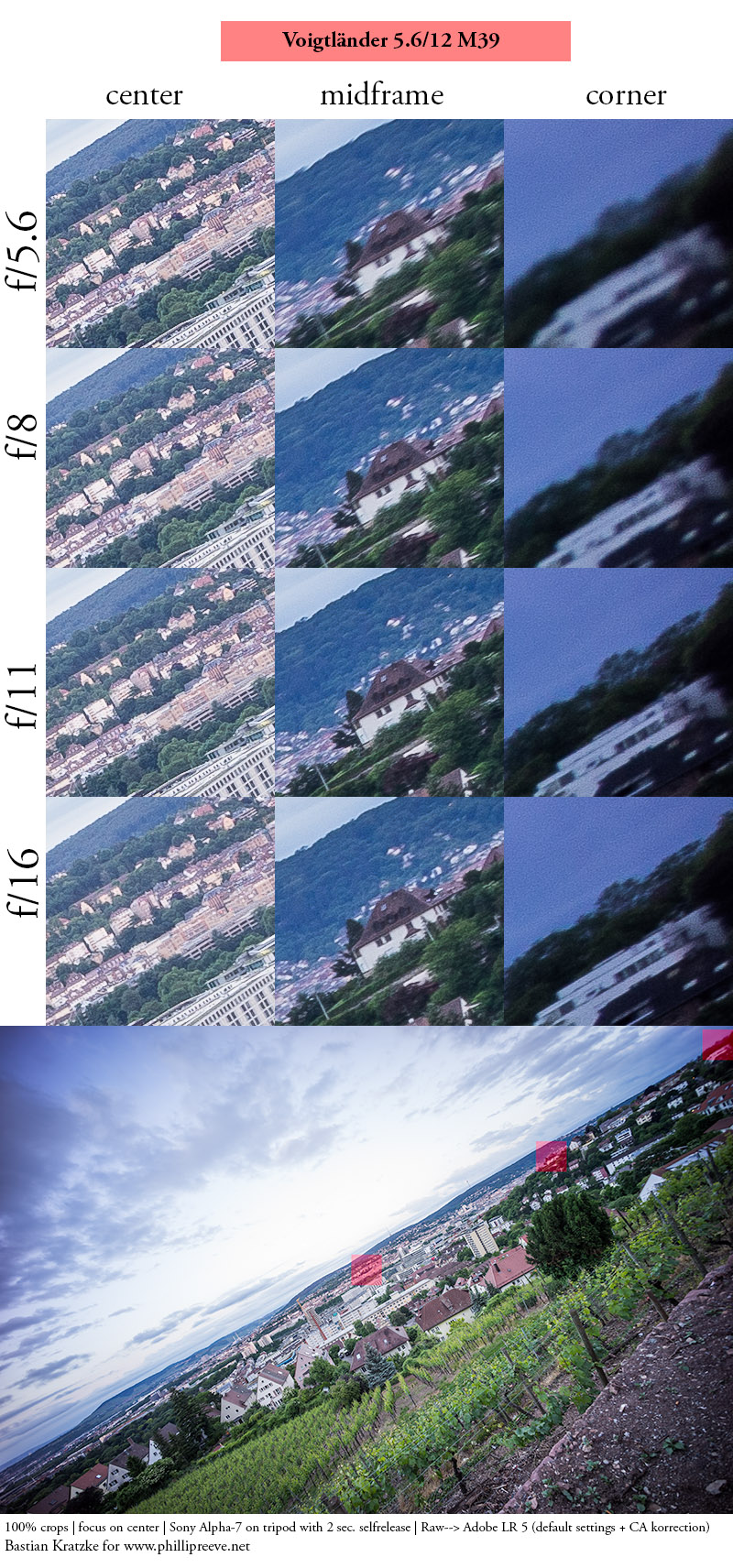
As most rangefinder wide angle lenses this lens exhibits quite a bit of field curvature due to the thick filter stack in front of the A7 cameras’ sensors. For the shots above spot metering has been used on the corners. I recommend using this lens at f11 (exclusively) to get the best results across the frame, especially in the corners. But take a look at the provided samples, to decide for yourself.
Flare resistance
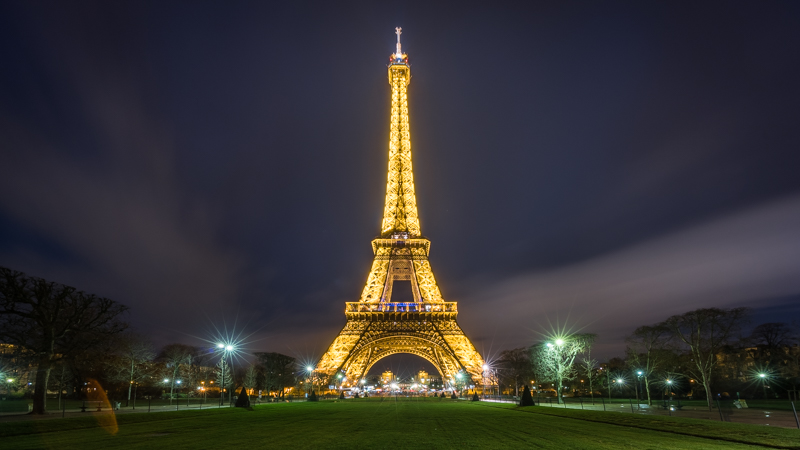
The flare resistance is quite good, especially for a 12mm lens. The example above shows the worst I could produce. Even with the sun in the frame the performance is very good:
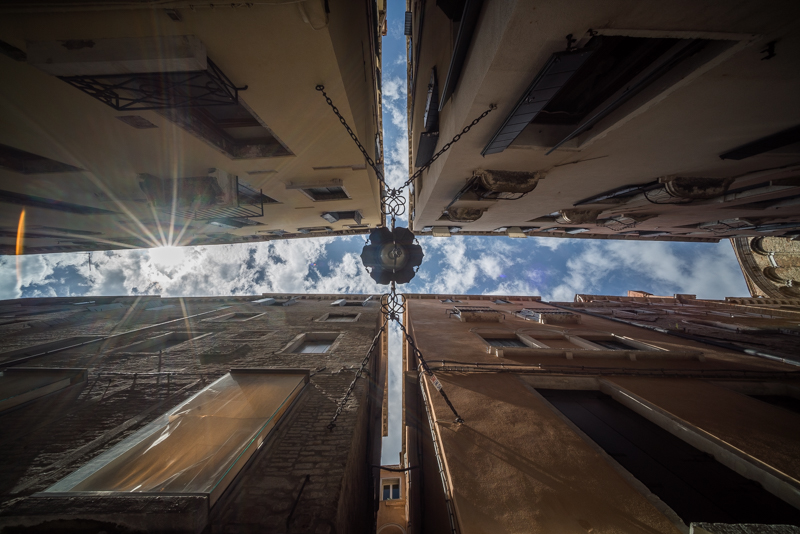
Distortion
The distortion is quite low, which is one of the positive side effects of the symmetrical lens design. There is also a profile embedded in Lightroom, which can be used.
Sunstars
This Voigtländer will produce 18-pointed sunstars, which may – dependent on the light source – not be perfectly defined, as shown in the example. Especially the different lengths of the rays do bother me sometimes, but it is up to your taste, what rendering you prefer. In my opinion the 28mm 2.0 Ultron and the 50mm 1.5 Nokton fare way better in this regard.
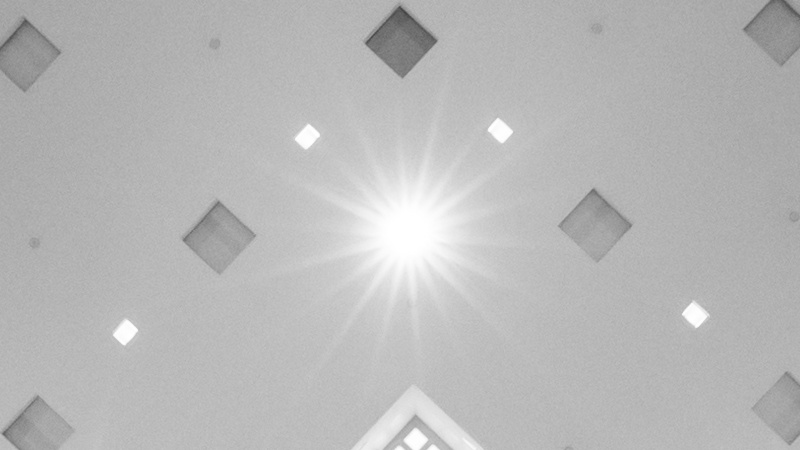
Chromatic aberrations
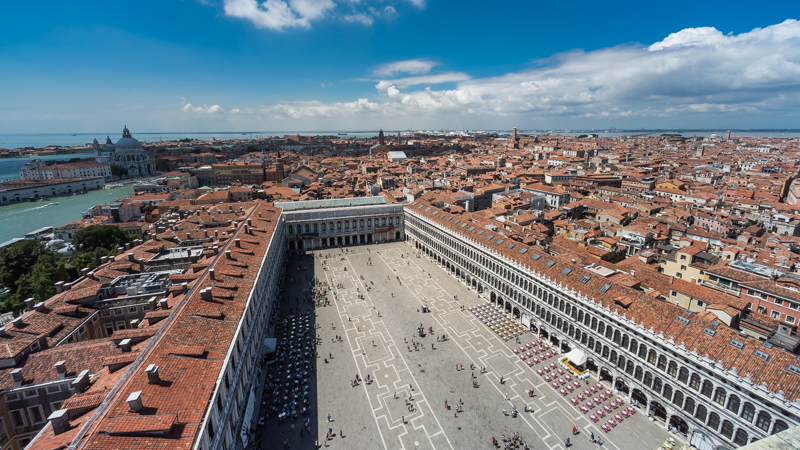
For such an extreme wide angle lateral CAs are very well under control and easily corrected in post, as can be seen in the example below (100% crop from the image above). You won’t notice any loCA with a lens with this parameters either. By the way, of all the photos I have taken with this lens, in this one the CAs were by far the worst. That is why I am showing this rather dull picture here.
Sony A7s | Voigtländer Ultra Wide Heliar 5.6/12 | f/11 | CA 100% crop before/after
Use with filters
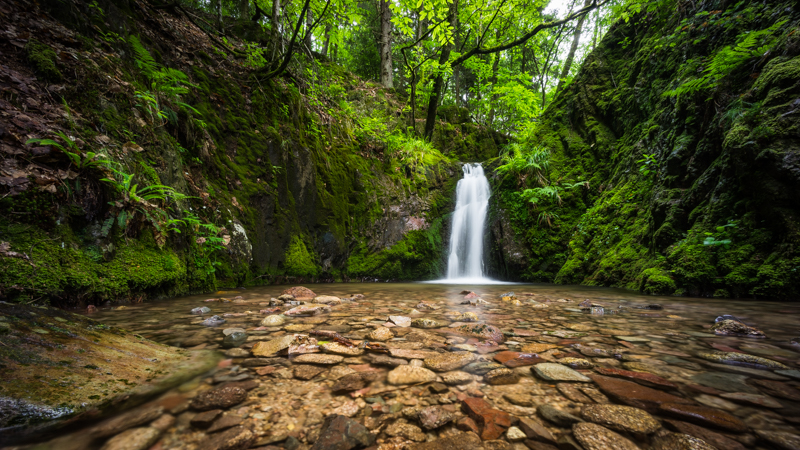
A rather unique feature of this lens is that you can use “standard” filters with it. For the likes of Samyang 14mm 2.8, Sigma 12-24mm, Nikon 14-24mm 2.8 and of course the Canon 11-24mm 4.0 (and quite a few more) you need huge specialized filters. This is also where we need to talk about the differences between the M39 and the newer Leica M version of this lens. The newer version takes 67mm filters and incorporates a non removable hood. This is the reason I prefer the older M39 version where the hood is removable and allows the use of a special “filter adapter” with a 77mm thread. The big advantage here is that you can use filter systems like the Lee 100mm system. The downside is, that this adapter is quite rare, so I recommend getting one of ebay.com (affiliate link). Because this lens was meant to be used with rangefinder cameras, the adapter has a hole to not block the viewfinder. If you intend to use strong ND filters you should cover this up as I did.
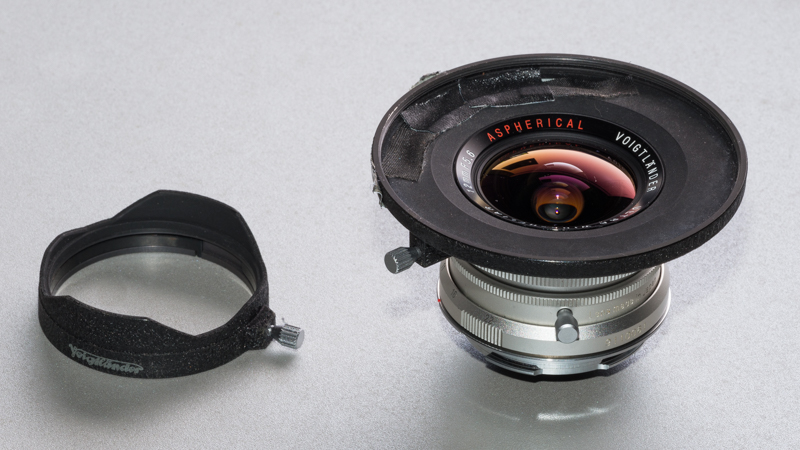
There is one more caveat here: there have been some situations with strong contra light where the markings on the lens were reflected by a filter and then recorded onto the sensor, as can be seen in the example below. This problem may not occur in every situation and/or with every filter, but keep in mind I used a Hoya Zeta polarizer here, which is known to be one of the best around.

Sample Images
I have set up a flickr album which contains many shots taken with the 12mm 5.6 Ultra Wide Heliar and I will add more pictures to that in the future.
Alternatives
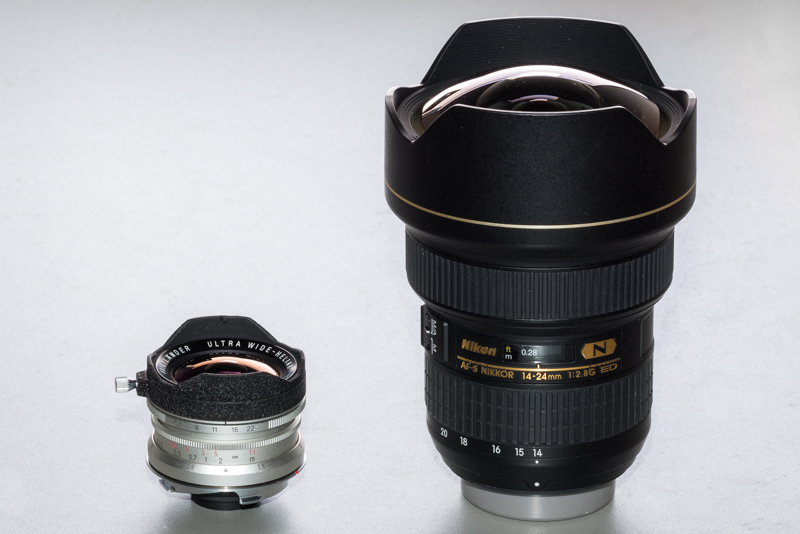
If you want something with the same field of view there are not many alternatives, actually just three: the two versions of the Sigma 12-24mm 4.5-5.6 and the new Canon 11-24mm 4.0. What you will immediately notice is that these lenses are huge and heavy in comparison and in case of the Canon also really expensive, but therefore you won’t notice any color shading, the vignetting will be less severe and the corner resolution ought to be better as well. If you don’t need to go that wide you might also consider the 15mm 4.5 Voigtländer or the Samyang 14mm 2.8 (which is still huge in comparison).
In case you are not in a hurry it may be worthwhile to wait for the newly announced E-Mount Voigtländer lenses.
The 10mm and 12mm are new designs and should therefore work better on digital sensors. But although it is true that the Leica M mount version III of the 15mm 4.5 does work better on digital sensors then the older versions (as was promised by the manufacturer), it is still not without flaws regarding corner sharpness and color cast. And because the new 10mm and 12mm designs were also announced with Leica M mount, it remains to be seen, whether there will be optical differences between the E-Mount and M-mount versions. I am very curious to check that out, as soon as they are available.
Conclusion
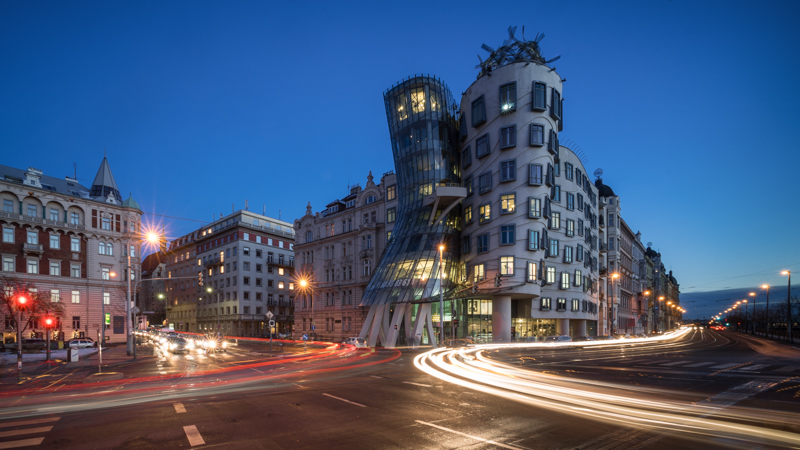
The one thing that really sets this lens apart from all the other ultra wide angle lenses is the small size and the small weight. I think twice before putting the huge, 35.3 oz/1,000g heavy Nikon 14-24mm 2.8G in the bag, but I always carry this 6.2 oz/175g Voigtländer 12mm 5.6 with me, when shooting with the A7s.
As a close second comes the ability to use decently sized filters. I don’t see myself carrying these huge 165mm filters and the even bulkier filter holders for my 14-24mm. Actually I don’t see anyone carrying these things.
Talking about the optics, you won’t see any resolution records with this lens, although the center of the frame leaves nothing to be desired. I would rate the corners “ok to good”, but because of the perspective distortion they can be quite hard to evaluate sometimes. I recommend taking a look at the full resolution samples I provided and check for yourself, if this is for you, or if you are more into one of the retrofocus lenses with higher bragging rights due to DXOmark’s best list.
I am also heavily into astro-landscape photography, as you may notice when taking a look at my corresponding flickr album. I didn’t talk about coma performance (which really isn’t great) here because the lens is so slow in the first place and I would totally not recommend it for shooting the milky way.
So, who is this lens for? The ability to use filters makes this a great landscape lens but the huge field of view makes if very suitable for architectural work as well. Anyone who shoots architecture knows, sometimes you simply can’t get wide enough in tight city spaces (the “dancing houses” by Frank Gehry in Prague at the top of this section are just one example). I also use this lens for some abstract photography, as you have probably already noticed by the provided examples 🙂
The M39 version reviewed here can mostly be found on the used market starting at around 450€/500$ while the M-Mount version will set you back roughly 700€/600$ (new).
The Voigtländer 12mm 5.6 Ultra Wide Heliar M39 usually sells for around $550 at ebay.com (affiliate link).
In Germany you can buy it for 400-600€ at ebay.de (affiliate link).
Support Us
Did you find this article useful or just liked reading it? Treat us to a coffee!
![]()
![]()
![]() via Paypal
via Paypal
This site contains affiliate links. If you make a purchase using any of the links marked as affiliate links, I may receive a small commission at no additional cost to you. This helps support the creation of future content.
Latest posts by BastianK (see all)
- Review: SLRmagic 50mm 0.95 Hyperprime LM - July 5, 2025
- Full Resolution Pictures getting fixed - July 4, 2025
- Analogue Adventures Part 42: A wedding with Eastman Double-X 200 - July 2, 2025



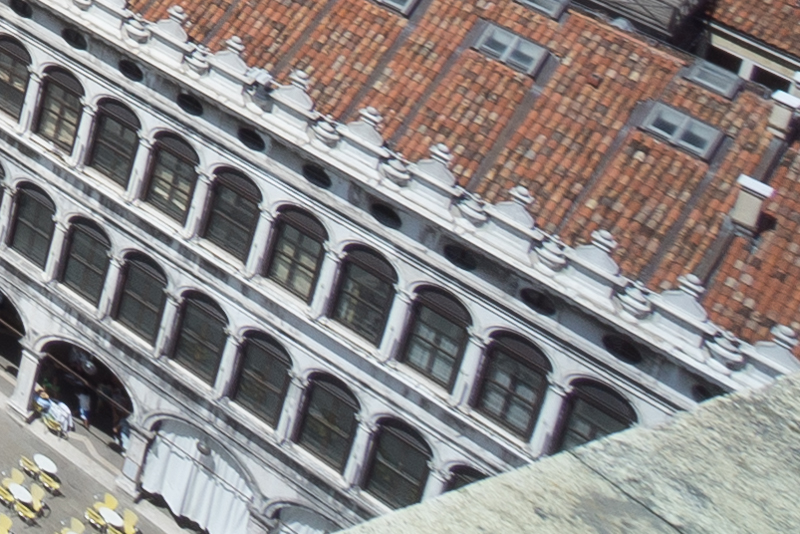
Thank you for the article! You surely know how to use the lens.
I have taped the markings on my lens with a matte black tape. This solved the reflection problem fully as far as I can tell.
To ease up the vignetting I’m also using a Heliopan center spot grad filter as originally suggested in a Luminous Landscape article.
Dear Paulus,
I guess I will cover up the markings as well (have already thought about it myself, but until now hesitated to do so 🙂 ).
I also used this lens with a center filter as well (generic Soligor) but unfortunately by giving up 2 stops in the center I only “gained” 0.3 in the corners, which I think is not worth the hassle.
But if your filter works better I am quite curious to see a with/without comparison. Maybe you can make such a small comparison and post it here, I would also like to add it to the review then.
Best regards
Bastian
Hello thanks for the article. What about another alternative samyang 14 f2.8 which exist in e mount and doesn’t cost much?
Dear Stephen,
I already mentioned that lens above.
Apart from that I would not recommend buying this lens with E-Mount, I would rather go for the Nikon version (way better resale value) and use it with an adapter.
Nice review, one were I was waiting for. Look forward to try the E-mount Voigts as the announced Loawa 12mmf2,8.
The last one seems promising as well.
The only problem, like you mentioned, is the use of filters and since I’m in a landscape mode I’m using them a lot, LEE stoppers & grads. The use of grads however can be overcome by using the new grad-app (play memories) but still seems a little difficult to use for me. But it works.
But on the other side does anyone have an idea about the performance of Nikon 14-24mm on the A7r or A7r2, IQ corners ?.
But just as you mentioned, Philip, would not like to use these huge filters…
But thanks again for this review of the 12mm.
Hi
im thinking of getting the emount version to replace my 14mm samyang which i then will only use for astro.
would you say the 12mm is a good replacement or too wide for general landscape ? is the 15mm more general usefull or is the 12mm fine and not too wide and too specialized ?
i know i repeat myself 😉
Chris
Dear Chris,
I think that mainly depends on what the next focal length in your kit is.
In mine it is a 20mm, which I also use more often than the 12mm.
If it is a 24mm or even a 28mm in yours I would rather go for the 15mm.
Hi there i am greatly interested in this lens to compliment my voigt 35 f1.2. I use it with the Sony a7ii and was wondering how this lens performs with the a7ii. Especially in terms of value being less than 500 usd vs say the latest v iii which cost double.
I am mainly a street photographer and want to play with a larger angle of view lens. Do you think this could be used for street shooting considering its small and discrete size too ?
Hey,
I took the shots for the sharpness section with the original A7, the A7II will look no different.
I am not an expert on street photography so I don’t know if a maximum aperture of 5.6 will suffice,
but you will easily be able to zone focus with that lens,
already at 5.6 almost everything is in focus when the lens is set to say 1m.
Hey Bastian, Great thanks for that. Just one more thing.. Its well documented and you mentioned as well about vignetting, purple fringing and corner smearing . The former 2 which can be mostly corrected in Lightroom and the latter from cropping slightly, Would you still recommend this over the released V3 as price and size is a major factor for me. Would you still recommend it despite its flaws In terms of value to price ?
Jerry
Dear Jerry,
I haven’t had the chance to use V3 of the 12mm 5.6 yet (unfortunately),
so I can’t really comment on the differences.
But when it comes to value and size I think the 12mm M39 is hard to beat.
The 12 and 15 mm LTM Heliar have a well different curvature of field than the VM (first) versions, that appear instead to be matched to the Sony A7r (I have two 15 mm, one LTM 2005 and one VM 2013). In effects, early 12 and 15 mm have strong curvature and color vignetting even on film (but the CA is only 0.03% on the Minolta 5400 II because of the absence of refraction though the stack).
CA and color vignetting are easy to be corrected by Capture One, which I highly recommend over PS/LR.
Second VM versions (also called VM III) have larger effective aperture at the borders, with slightly higher resolution, even if at the expense of distortion and other asymmetry issues.
In VM II and III versions (maybe later ones..), the quality of the photo with the A7r and suitable software is IMHO the best available and more popping, resolved and tone modulated than with ZF 15-18 or Samyang 14 (i also got ZF 18/3.5 and Samyang 14), while the 14-24 has poor resolution, with a whoppy roll-off at high spatial frequencies, even at the center of the image, and dummy contrast.
Hello.. any could let me know where I could get M39 (old model),, with no fix cap to adapt filters?..
Thanks in advance.
Getting the lens off ebay isn’t tricky (you can use the links in the article), but you need the filter adapter which is rarer. Last time I checked B&H had one in stock…
Why will a regular step-up ring not work?
Because the M39 version of this lens does not have a regular filter thread.
Thanks
Bastion/Philip are you able to comment on whether there are any appreciable differences in image quality between the VM 12mm Heliar III and its E-mount equivalent on A7 system cameras?
Background: I’m trying to avoid E-mount lenses where possible in case, one day, I want to switch to a different camera manufacturer, but I don’t want to hugely sacrifice IQ. For example, I find the VM 15mm III works great on my A7r and A7s, and I’m okay with its shortcomings.
10mm 5.6, 12mm 5.6 II and 15mm 4.5 III have identical optics, so you can use the VM version.
Hi Bastian,
Thanks for all your articles, they are so helpful and you are so passionate.
I wondered if you could answer whether on the A7S, if either the M39 or M Mount connect electronically to the camera so I can digitally alter the f stop? With a sony adapter of course.
I doubt you can do it on the M39 but I wonder if the newer version allows that.
Thanks so much in advance!
Carla
Hi Carla,
only the new, bigger E-mount version of the 5.6/12 has electronic contacts to communicate with a Sony camera. And even then you can’t change the aperture with the camera but you need to use the aperture ring.
Best
Phillip
Hi Phillip,
Thanks so much for your response.
Ah, if the new E-mount (or M-mount) also require you to change to the aperture on the ring … the older version is probably better!
Apart from it being new, what would say / think of the new E-mount considering its substantial price increase?
Thank you – what a great little lens. Think I might be on the verge of getting one …
The new version is sharper with less vignetting and no color cast. If size or price can be overcome the new version should be quite a bit more fun.
Hmm fair enough. I guess that’s what you gain from updates of course!
Thank you very very much for your input.
Carla
Hi, I donot understand why the vignetting examples show strictly same pictures (small white round spot in a black surround) at all f/stops. And I cannot believe the vignetting is so strong (looks if there were 10 f/stops, because the sides and corners are quite black). MYbe you made some mistake?
Marc
Wideangle lenses for rangefinder cameras often do not improve in this aspect when stopped down. Check out Zeiss’ official data for the ZM 2.8/15 for example.
You overestimate the vignetting by a lot. It is really strong but more like 3-4 stops. If it was 10 stops Bastian couldn’t have corrected it in the before/after sample.
I am drawn to your review by talk of using the 12 with the 100×100 or 100x150mm filters. Do you have experience with putting the 77mm holder adapter on the lens adapter? was it a bit fussy about placementt? Which makers filter adapter did you try? Lee? Other? And about hte vignetting possibility…. was there any vignetting due to the filter adapter?
Thanks
Frank
Attaching a filtersystem to the lens’ filter adapter is no problem.
Back in the day I was using a Lee holder and if I remember correctly not even with a thick 105mm Sigma polarizer there was any vignetting.
I would recommend a more modern holder like the NiSi V5 (pro) nowadays though as handling is so much better compared to the Lee.
Thanks for your comments. There is almost nothing written about filters on the M39 version lens, and less on using 100×100 filters. Vignetting was my big concern. I have a Lee holder plus a cheapo copy. I will go ahead and order the Voigtlander adapter. Something will work
M6 0.85 with capital MADE IN GERMANY
https://www.marktplaats.nl/v/audio-tv-en-foto/fotocamera-s-analoog/m2052131493-leica-m6-0-85-classic?correlationId=dc31119f-cfdd-409c-90ae-7199b1fa1688
Hi,
Thank you for this great review. I was wondering if the team planned to put together a “best of” list for lenses suitable for architectural photography? This would be a great addition to your other lists—and also would suit me quite well since that’s what I primarily shoot!
If you were to recommend a lightweight architecture photography kit, what would you recommend?
We will discuss that.
Hello!
Thanks for your review, I bought this glass for my A7r3 and seems to get more details and less problems than the older.. I think BSI gives a boost on that.
Can you help me to find the 77 mm adapter? seems to be IMPOSSIBLE everywhere in the world (Europe, in the USA you can buy it but no one send to UK).
No I can’t. Only store I found that has it listed was B&H when I wrote the review.
Hi Bastian,
I am not sure if you would response to this comment since it is published so long ago, but anyway, I have a quick question.
I don’t understand the part where you mentioned about coma performance and that lens is so slow. I don’t understand what it means by lens is so slow, and also why this lens is not recommended for Milky Way photography.
Thanks
Maybe have a look at this article which contains some explanations.
“This is the reason I prefer the older M39 version where the hood is removable and allows the use of a special “filter adapter” with a 77mm thread”
I do have old Leica M version, design and everything as M39 version, and it do have removable hood (new Leica M doesn’t have it). It is quite strange, that I spent probably an hour on internet to find Leica-M with removable hood and didn’t find any information on that! All pictures show M39 version. By the way, I have black version. I found information that this version was released in 2000 for M39 mount. https://lens-db.com/cosina-voigtlander-ultra-wide-heliar-12mm-f56-aspherical-ltm-2000/ but mine has Leica-M 🙂 Photos of my version: https://imgur.com/a/IZSUwtf
Are you sure there isn’t a thin M39 -> Leica M adapter installed? Sure looks like it.
I also was wondering that, but I tried to find how to disassemble that, and it looks like there is no adapter and it is real mount plate.
Or maybe it has been glued 🙂
You were right! That’s an adapter. It is of very good quality, I managed to disassemble that. Here is the pic https://i.imgur.com/1OBZJ2v.jpg
I realize this is years later, but one added comment: I am using the M39 12mm with an M-mount adapter on Fujifilm X-series camera (mostly on an Xpro-2) with Fujifilm-brand M to X mount adapter, which gives me a very nice and tiny 18mm equivalent lens with much less vignetting. I use a much larger retro focus design Laowa 12mm f/2.8 on Nikon F and Z cameras for full-frame, but it is not an itty bitty carry all the time lens!